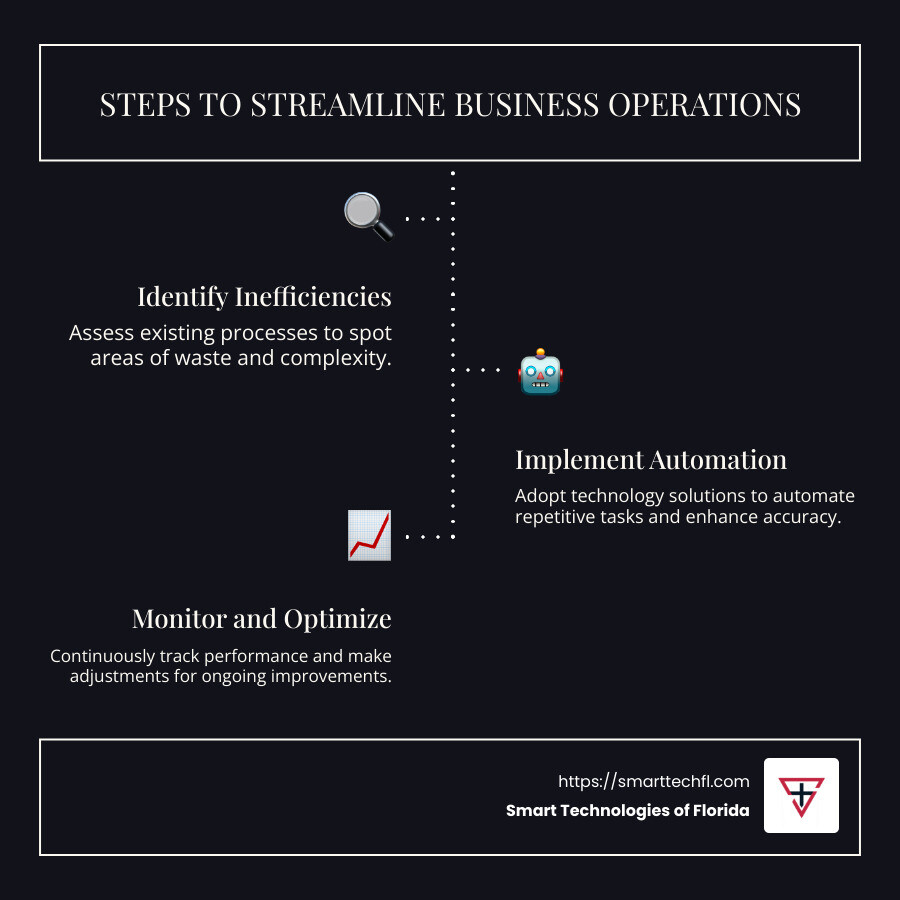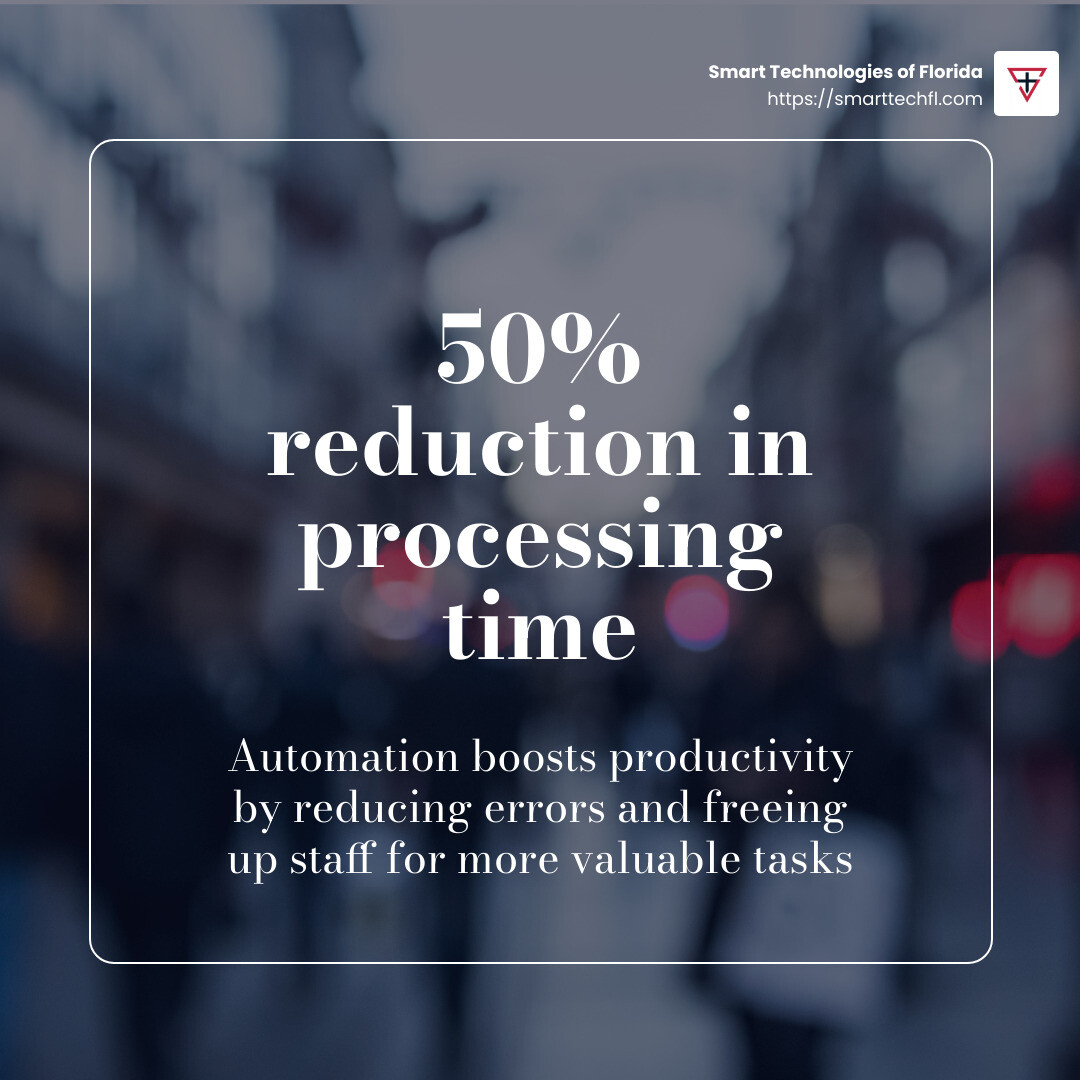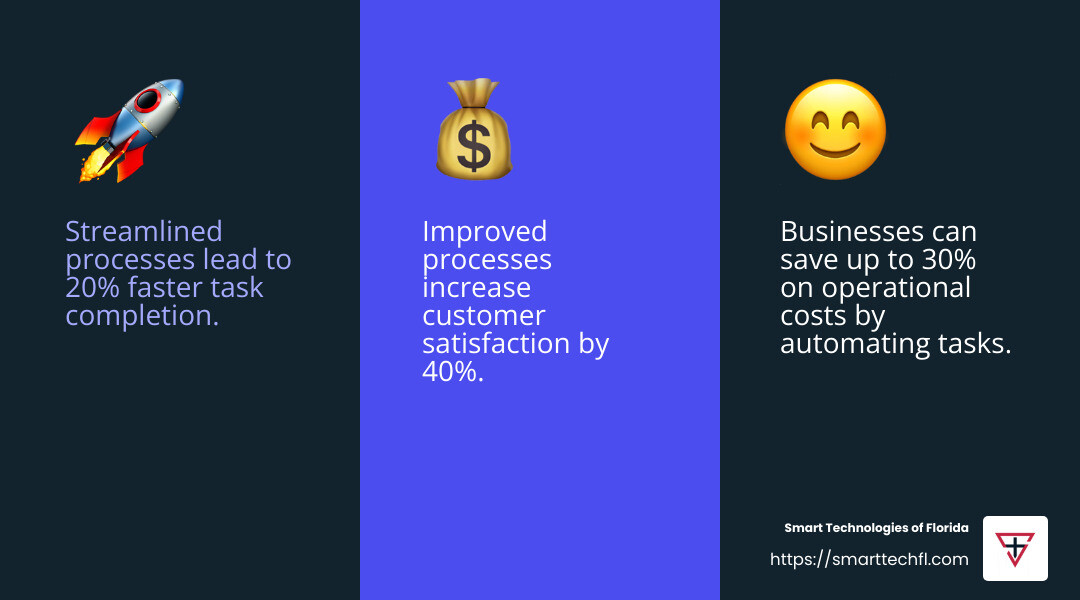Unlocking Efficiency: A Guide to Streamlining Business Operations
Streamline business operations to open up unprecedented efficiency and foster growth. Imagine your retail business thriving through reduced operational costs and improved customer engagement. This change is within reach by simplifying your processes to eliminate waste and improve productivity.
- Operational Efficiency is key to thriving in today’s competitive market.
- Streamlining involves simplifying complex processes, removing unnecessary steps, and adopting technology that helps your team work smarter.
- Business Change means making strategic improvements that empower your staff and boost the bottom line.
Are you ready to explore how streamlining can revolutionize your operations? Dive in to find how to achieve seamless business processes that lead to sustained success.

Understanding Streamlining in Business Operations
Streamlining business operations is all about process improvement, making things run smoother and faster. Imagine a busy kitchen where every chef knows exactly what to do, and there’s no wasted motion. That’s what streamlining aims to achieve in your business.
Process Improvement
Process improvement is like tidying up your workspace. It’s about identifying areas where things get stuck or take too long and finding ways to fix them. For example, if your team spends hours every week on manual data entry, automating this task can save time and reduce errors.
Efficiency
Efficiency means doing more with less. It’s not just about cutting costs but using resources wisely. One company found that by integrating their software systems, they could reduce task duplication and save 20% on operational costs. This kind of efficiency helps your business grow without needing more resources.
Simplification
Simplification is the art of making things easier. Think of it as decluttering your processes. By removing unnecessary steps, you make it easier for your team to get things done. This not only speeds up operations but also reduces the chances of mistakes.
For instance, a retail business might streamline its order processing by using a single platform for all orders, instead of juggling multiple systems. This simplification can lead to faster delivery times and happier customers.
Incorporating these elements into your business can transform the way you operate. By focusing on process improvement, efficiency, and simplification, you set the stage for a more agile and responsive organization.
Ready to explore the top strategies to streamline your business operations? Let’s dive deeper into automation, data integration, and more.
Top Strategies to Streamline Business Operations
Streamlining business operations can feel like a daunting task, but with the right strategies, it becomes manageable and highly rewarding. Let’s explore some of the most effective strategies, including automation, data integration, lean principles, and process mapping to open up efficiency in your business.
Automation
Automation is about letting machines handle the repetitive, mundane tasks so your team can focus on what truly matters. Imagine a scenario where your staff no longer spends hours on data entry. Instead, automated systems capture, process, and store this data with minimal human intervention. This not only boosts productivity but also significantly reduces errors.
In fact, businesses that have accepted automation report up to a 50% reduction in processing time. By implementing automation, you not only save time but also create a more dynamic and agile work environment.

Data Integration
Data integration is like connecting the dots between different parts of your business. When your systems talk to each other, it eliminates silos and ensures everyone has access to the same, up-to-date information. This seamless flow of data supports better decision-making and improves operational efficiency.
For instance, integrating your customer relationship management (CRM) system with your marketing tools can provide a 360-degree view of customer interactions, leading to more personalized marketing strategies and improved customer satisfaction.
Lean Principles
Lean principles focus on maximizing value while minimizing waste. This approach, inspired by the Toyota Production System, is all about continuous improvement. By identifying and eliminating non-value-adding activities, businesses can streamline workflows and increase productivity.
Consider a manufacturing company that adopts lean principles to refine its production line. By reducing bottlenecks and eliminating unnecessary steps, the company not only speeds up production but also improves product quality and customer satisfaction.
Process Mapping
Process mapping is a visual representation of your business processes. It helps you see where each step fits in the overall workflow and identify areas for improvement. By mapping out your processes, you can spot inefficiencies and redundancies that might not be evident otherwise.
For example, a company might find through process mapping that approvals for a project take too long because they go through multiple unnecessary levels. Streamlining this process can lead to quicker decision-making and faster project turnaround times.
By focusing on these strategies—automation, data integration, lean principles, and process mapping—you can transform your operations into a well-oiled machine. These strategies not only improve efficiency but also empower your team to focus on innovation and growth.
Ready to dive into best practices for streamlining business processes? Let’s explore how mapping, automation, and communication can further improve your operations.
5 Best Practices for Streamlining Business Processes
Streamlining business processes involves making them more efficient and effective. Let’s explore five best practices that can help you achieve this: mapping current processes, automating repetitive tasks, standardizing and simplifying, leveraging data analytics, and improving communication.
Map Current Processes
Process mapping is the first step in understanding how your business operates. By creating a visual diagram of each process, you can identify inefficiencies and redundancies.
Imagine a flowchart showing the steps involved in processing customer orders. You might notice that approvals take longer than necessary due to multiple sign-offs. By simplifying this step, you can speed up order processing and improve customer satisfaction. Visual tools like flowcharts and diagrams make it easier to pinpoint bottlenecks and areas for improvement.
Automate Repetitive Tasks
Automation is a game-changer when it comes to handling repetitive tasks. By automating data entry or routine calculations, you free up your team to focus on tasks that require human insight and creativity.
Consider a scenario where invoice processing is automated. Instead of manually entering data, the system captures and processes invoices automatically, reducing errors and speeding up the workflow. This not only boosts efficiency but also improves accuracy.
Standardize and Simplify
Standardization and simplification are about creating consistent procedures that everyone follows. This reduces variability and makes it easier to maintain quality.
For example, using templates for regular reports ensures that all necessary information is included and presented consistently. It also makes cross-training easier, as employees can quickly learn standardized processes.
Leverage Data Analytics
Data is powerful. By leveraging data analytics, you can gain insights into how your processes are performing. Tracking key metrics helps identify areas for optimization.
For instance, analyzing data on customer service interactions can reveal patterns, such as peak inquiry times. With this information, you can allocate resources more effectively to improve response times and customer satisfaction.
Improve Communication
Effective communication and collaboration are crucial for streamlining processes. When everyone is on the same page, decisions are made faster, and projects move smoothly.
Tools that facilitate communication, like integrated chat and video conferencing platforms, ensure that information flows freely among team members. This reduces misunderstandings and keeps everyone aligned toward common goals.
By adopting these best practices, you can streamline your business processes, reduce costs, and improve overall efficiency. Each step builds on the others, creating a cohesive strategy that drives your business forward.
Next, we’ll explore the benefits of streamlining business operations and how it impacts your bottom line.
Benefits of Streamlining Business Operations
Streamlining business operations isn’t just a buzzword; it’s a powerful strategy that can transform your organization. Let’s explore the key benefits: increased efficiency, cost reduction, and improved satisfaction.
Increased Efficiency
Efficiency is the backbone of any successful business. By streamlining operations, you eliminate bottlenecks and redundancies, allowing tasks to be completed faster and with less effort.
Consider a company that automates its order processing. This change reduces manual errors and speeds up the time it takes for an order to move from placement to delivery. Employees can focus on higher-value tasks instead of repetitive ones, boosting overall productivity.
Cost Reduction
When processes are streamlined, costs naturally decrease. Automation and process improvements can lead to significant savings by reducing the need for manual labor and minimizing waste.
Take the example of a business that automates its invoicing. By eliminating paper invoices and manual data entry, the company not only saves on materials but also reduces the time employees spend on administrative tasks. These savings can be substantial over time, improving the company’s bottom line.
Improved Satisfaction
Streamlined operations lead to faster service and higher quality, which translates to happier customers. When businesses can deliver products or services more efficiently, customer satisfaction increases.
Imagine a scenario where a customer service department uses data analytics to identify peak times and allocates resources accordingly. This proactive approach reduces wait times and improves the customer experience. Satisfied customers are more likely to return and recommend your business to others, driving growth.

In addition to customer satisfaction, employee satisfaction also improves. When employees are freed from monotonous tasks, they can focus on more meaningful work, leading to higher job satisfaction and retention.
By focusing on these benefits, businesses can create a more agile and competitive operation. Streamlining isn’t just about cutting costs—it’s about building a robust foundation for long-term success. Next, we’ll address some frequently asked questions about streamlining business operations.
Frequently Asked Questions about Streamlining Business Operations
What is streamlining business operations?
Streamlining business operations is all about making processes more efficient and simpler. Think of it as cleaning up your business’s daily tasks. You cut out the unnecessary steps and focus on what truly matters. This means reducing waste, saving time, and boosting productivity.
For example, instead of having multiple forms for the same task across different departments, you create one standard form. This simple change can save time and reduce errors. The goal is to make things run smoother, so your team can focus on important work.
How can data be used to streamline operations?
Data is like a treasure chest for businesses. When used wisely, it can help streamline operations in amazing ways. By integrating data from various sources, businesses can spot patterns and find areas needing improvement.
For example, data analytics can show you where bottlenecks happen in your order processing. With this insight, you can automate those parts, speeding up the process and reducing mistakes. Automation tools can handle repetitive tasks, freeing up your team to focus on more complex issues.
What are examples of streamlined processes?
Streamlined processes are everywhere. Here are a couple of examples:
- Invoicing: Traditionally, invoicing involved a lot of paperwork and manual data entry. Now, businesses can automate invoicing. This means invoices are generated and sent automatically, reducing errors and speeding up payments.
- Order Processing: Manual order processing can be slow and error-prone. By automating this process, businesses can ensure orders are checked, approved, and fulfilled quickly. This not only improves efficiency but also improves customer satisfaction.
Streamlining is about working smarter, not harder. By focusing on efficiency and simplification, businesses can achieve better results with less effort.
Conclusion
At Smart Technologies of Florida, we believe that streamlining business operations is not just about adopting new tools, but about embracing a holistic change. With 23 years of experience, we specialize in crafting digital solutions that align with your unique business goals. Our approach is deeply rooted in strategic change and innovation, ensuring that every change is meaningful and long-lasting.
Our people-centric approach sets us apart. We prioritize collaboration and understanding, working closely with your team to ensure that every change is acceptd and effectively implemented. This means empowering your business to not only adopt new technologies but to truly integrate them into daily operations.
By focusing on strategic change, we help businesses open up their full potential. This involves simplifying processes, reducing waste, and enhancing productivity. Our custom solutions aim to make your operations as efficient as possible, allowing your team to focus on what they do best.
Ready to take the next step in changing your business? Find how our business process automation solutions can help you streamline operations and achieve greater efficiency. Let’s work together to create a smarter, more efficient future for your organization.












